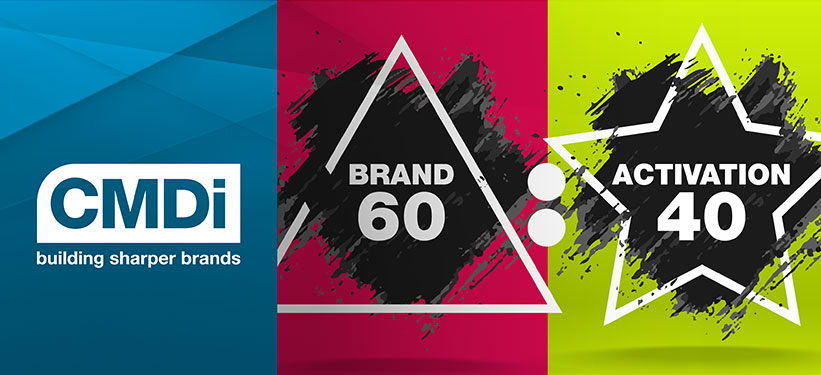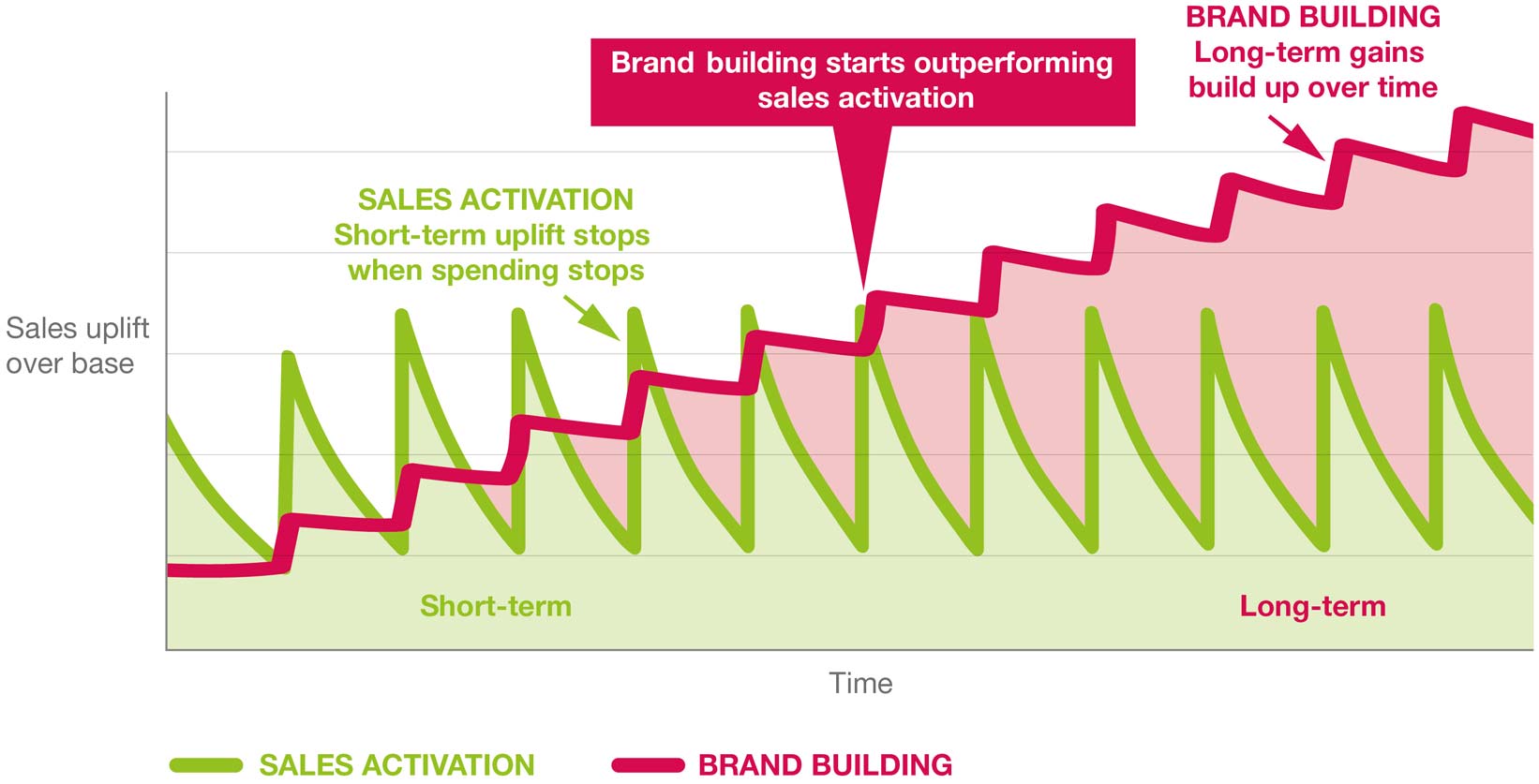The cost of short-termism
Ask any CEO about the importance of long-term thinking, and they’ll agree it’s crucial. Ask any CMO about the importance of brand and marketing spend and they’ll say the same.
So why do many organisations – especially in the built environment sector – fall into the trap of short-term marketing with insufficient spend focused on long-term brand building?
The golden ratio for brand-to-action spend that generates optimal results has been proven to be 60:40 (more on that later). Yet too many businesses continue to fall into short-term activation behaviours, as market pressures cause them to lose their nerve for holding onto longer-term strategies with greater investment in brand.
It’s a classic case of emotions overriding reason. Numerous studies show how business leaders and marketers who think and act long-term, investing over 60% of their budget on brand, consistently outperform their competitors.
But when it comes to the crunch, will you trust reason, reports and published results? Statistically, probably not. But here’s why you should.
The shortcomings of short-termism
Short-termism is hardly a recent phenomenon in business, but the digital era has certainly accelerated it. In so many areas, but particular in built-environment marketing, the rush to jump on the digital bandwagon and go for quick-win ROI has not led to greater market share over time. In fact, it’s led to the demise of many businesses as we shall see.
The thing is, we want and now expect everything to happen sooner. Yes, the immediacy of digital activation campaigns gives executives and managers an easy button to click when they’re under pressure. And yes, it can deliver short-term results that will often satisfy your monthly sales impact reports.
But (and it’s a big but) two major recent studies have shown that long-term strategies outperform a short-term approach.
The long-term facts
A UK study by the Institute of Practitioners in Advertising (IPA) analysed 500 effectiveness case studies over 20 years. Its results revealed that long-term campaigns were 200% more efficient than short-term campaigns, 200% more likely to drive market-share improvement, and 60% more likely to deliver profit improvement.
Similarly, research by McKinsey covered more than 600 large and mid-sized companies over the past 15 years. Its results revealed that companies with long-term strategies enjoyed 47% more growth than other, had 36% higher earnings, and added average market capitalisation of around £5.5 billion.
The reason in each case? Because the short-term campaigns only produced a temporary spike in sales, whereas the long-term campaigns produced the opposite effect.
Both the IPA and McKinsey reports highlight the difference between successful organisations that struck the optimal balance between short and longer-term marketing investment, and the far less successful companies who couldn’t kick the short-termism habit… with painful clarity.
Learning from different industry sectors are powerful indicators of truths that apply to others. The McKinsey report, for example, shows learnings from the decline of the retail industry over the past 10 years, which can be useful when applied to the UK Merchant model. Sales figures from the department store category as a whole highlight the consequences of 10 years of activation-driven marketing – from direct marketing and sales promotions to catalogues and online ads – at the expense of building brand campaigns. The report points to the lack of memorable long-term brand campaigns in the past 10 years for most department stores. As a consequence, it says, the category has seen just 5.6% growth in the past 10 years, while CPI rose 27%, and all retail grew by 46%.
The ‘John Lewis’ effect
Now consider the success story of John Lewis. That organisation set out their long-term marketing strategy way back in 2009 to win over the hearts and wallets of audiences nationwide during the critical Christmas period. By 2014, its annual Christmas TV adverting campaign had grown to become one of the most anticipated in the world. The consequence of such long-term brand-building focus was generating £8 of profit for every £1 invested in the campaign.
Such long-term success in the UK has been seen all around the planet by these reports. Retailers (always a key marker for general sales success) as far afield as Australia that have stuck to long-term strategies have seen their earnings grow by us much as 177%.
Clear and inspiring examples can also be seen in the FMCG sector, highlighting the difference investment in the long term makes over short term strategies in terms of tangible outcome. Following an abrupt switch away from short-termism in 2008, the companies that have actioned powerful long-term strategy which involves TV, sponsorship and even celebrity endorsement have consistently see their market positioning increase.
Huggies in the US is another classic case study, with parallels for all business in the UK: they followed a long-term ‘John Lewis’-style approach to branding by leveraging strong emotional appeal. It is now one of the best-known and longest running campaigns in the States which has helped it maintain a market share of over 55% for over 20 years. It also helped them fend-off two attempts by the current number one brand to enter the market, as well as competitors launching own-brand products at a lower price.
The cost of short-termism
For many companies, the cost of short-termism is terminal. The built environment sector can even learn from packaged goods brands that have diverted their brand investment to short-term trade marketing and activation, especially those with a heavy distribution reliance on the big supermarket chains.
Long-term and well-loved campaigns for household brands such as instant coffee, biscuits, shampoo, pasta, breakfast cereal, and frozen food were commonplace 20 years ago but are rarely seen today. So, how are they faring? Well, the latest IBISWorld data shows many of the companies in these categories again had flat sales in recent years.
The best of both worlds
Interestingly, rather than simply concluding that ‘long-term’ is best, the IPA’s study showed that long-term brand-building campaigns and short-term activation campaigns worked best when working together. Strong brands enjoyed better results from their digital activations and, in turn, strong digital activations drove higher sales for that brand.
The invaluable question is how to strike that balance between brand and activation. How much CEOs and CMOs should invest in their long-term marketing versus short-term strategies? The answer came from the IPA’s study which found that “on average, effectiveness seems to be optimised when around 60 per cent of the communications budget is devoted to brand building, and around 40 per cent to activation”. And for campaigns lasting longer than six months.
How to balance long-term brand building and short-term activation
1. Start with the brand, never the tactics – this is the first tip for good reason, and your key to getting the balance right. Because a strong brand is unique and can’t be copied, whereas tactics are what everyone is doing or could copy.
2. Find your purpose – Brands that continue to thrive have one thing in common: they stand for something that matters to the people who matter. They have a clear purpose. And even as their market evolves, and they stay agile, they remain true to that purpose. Your brand’s purpose is its reason for being. It acts as your anchor in a sea of change. When your brand launches new products and services, adopts new technologies, complies with new legislation, and responds to changing needs, finding its purpose means it never loses direction.
3. Sharpen your point of difference – Defining what makes your business different is vital to ensure greater market share and profitability. In today’s multi-channel world, this needs to be considered from every audience and channel perspective, so your point of difference shines out at every opportunity.
4. Investing in customer insight and research isn’t a luxury, it’s a necessity – This ensures your customers are at the heart of sales, product and service strategy – so growth becomes sustainable because it’s based on robust customer understanding, not simply the need to grow. This may sound obvious but it’s so often forgotten by many brands and organisations in the built environment. Products and services that are sharply focused on customer needs will always perform better than those who are not.
5. Build the best short-term tactics to achieve your goals – BUT only once you have clearly defined the four points above. Doing it the other way around never works and often ends up wasting more budget. ROI can only be truly measured based on long-term goals. The gap between your short-term activation results and your long-term brand building will soon start to grow.
6. Digital shouldn’t be dull, and should be an extension of your brand – With so much sales activation reliant on digital or telesales channels, ensure your brand message translates without losing emotion and that the customer brand experience is fully integrated across retail, online, telesales and event touchpoints. The winners are those who see sales activation as an extension of the brand experience. Sales, brand and marketing must be truly aligned at every point to hit the mark, and score the profits.
7. Ensure the board understands the need to get the balance right – It’s all for nothing if the Board isn’t on board. They need to clearly understand that it’s not brand or activation spend, it’s a balance of the two. A 60:40 ratio to be precise, for optimal results, with campaigns lasting no less than six months. Those who heed these lessons and strike that balance will see the results, and count the rewards.

